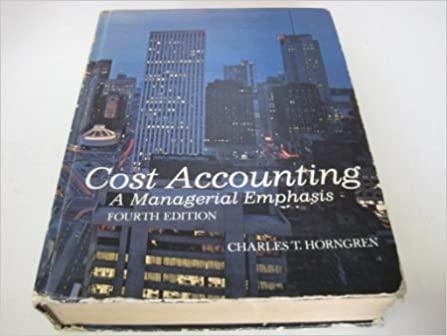Analysis of Channels of Distribution and Territories The Manning Co. has three sales territories that sell a
Question:
Analysis of Channels of Distribution and Territories The Manning Co. has three sales territories that sell a single product. Its income statement for 19_2 contained the following data:
TERRITORY Total A B Cc Sales: 100,000 units, @ $11 $1,100,000 $550,000 $330,000 $220,000 Cost of goods sold, including $100,000 of fixed factory overhead $ 500,000 $250,000 $150,000 $100,000 Gross margin $ 600,000 $300,000 $180,000 $120,090 Order-filling costs:
Freight-out $ 68,000 $ 34,000 $ 20,400 $ 13,600 Shipping supplies 50,000 25,000 15,000 10,000 Packing and shipping labor 50,000 25,000 15,000 10,000 Total $ 168,000 $ 84,000 $ 50,400 $ 33,600 Order-getting costs:
Salesmen’s salaries $ 50,000 $ 50,000 Salesmen’s commissions 26,400 $ 26,400 Agents’ commissions 11,000 $ 11,000 TERRITORY Total A B Cc Sales manager’s salary 30,000 15,000 9,000 6,000 Advertising, local 80,000 40,000 24,000 16,000 Advertising, national 100,000 50,000 30,000 20,000 Total $ 297,400 $155,000 $ 89,400 $ 53,000 Total marketing costs $ 465,400 $239,000 $139,800 $ 86,600 Administrative expenses:
Variable $ 50,000 $ 25,000 $ 15,000 $ 10,000 Nonvariable 100,000 50,000 30,000 20,000 Total administrative expense $ 150,000 $ 75,000 $ 45,000 $ 30,000 Total expenses $ 615,400 $314,000 $184,800 $116,600 Net operating income $ (15,400) $ (14,000) $ (4,800) $ 3,400 Territory A contains the company’s only factory and central headquarters.
This district employs five salaried salesmen.
Territory B is 200 to 400 miles from the factory. The district employs three salesmen on a commission basis and advertises weekly, locally.
Territory C is 400 to 600 miles from the factory. The district employs three manufacturers’ agents. Local advertising costs are split fifty-fifty between the agents and the company. Cost per unit of advertising space is the same as in Territory A.
The following variable unit costs have been computed:
Freight-out, per unit $.50, $.70, and $1.10, for Territories A, B, and C, respectively Shipping supplies, per unit .50 Packing and shipping labor, per unit 50 Variable administrative cost, per sales order 2.00 Territory A had 17,000 orders; Territory B, 6,000; and Territory C, 2,000.
Local advertising costs were $60,000, $15,000, and $5,000, for Territories A, B, and C, respectively.
required 7. Mr. Manning asks you to recast the income statement in accordance with the contribution approach that he heard described at a recent sales convention. Assume that fixed manufacturing overhead, national advertising, the sales manager’s salary, and nonvariable administrative expense are not allocated.
2. What is the contribution controllable by the segment manager per order in each territory? What clues for management investigation are generated by such a computation?
3. The salesmen in Territory B have suggested a saturation campaign in local newspaper advertising, to cost $30,000. How much must the sales volume in Territory B increase to justify such an additional investment?
4. Why does Territory A have the highest contribution-margin percentage but the lowest territorial-margin percentage?
5. On the basis of the given data, what courses of action seem most likely to improve profits? Should Territory A be dropped? Why?
Step by Step Answer:






